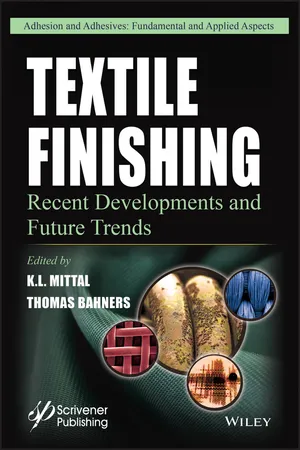The chapter reviews the most important antimicrobial agents for textiles and the mechanisms of their antimicrobial activity. Structures of the leaching and the bound compounds are presented and their modes of antimicrobial functions are discussed. In addition to active antimicrobial agents, the structures of low adhesion compounds and their “passive antimicrobial activity” are also presented. The importance of dual-action antimicrobial coatings consisting of combined controlled release and biobarrier forming active antimicrobial compounds as well as the active antimicrobial and low adhesion agents is highlighted. Standard microbiological test methods for the determination of the efficiency of antibacterial and antifungal activity of the agents on textiles are described and their pros and cons are discussed. Health and environmental impacts of the antimicrobial compounds are discussed as well as the future trends of their use are indicated.
1.1 Introduction
The development of effective antimicrobial protection of textile substrates has enabled the expansion of the use of textile products in various industrial sectors, including protective and technical textiles, pharmacy, medicine, transport, tourism, agriculture, and food [1]. It includes protection against all types of microorganisms, i.e., bacteria (antibacterial), viruses (antiviral), fungi (antifungal) and protozoa (antiprotozoal). It may be intended for the protection of the users or the textile fibers. The former protects people against pathogenic and odor-causing microorganisms, which can lead to health and hygiene problems. The latter protects textile substrates against adverse textile aesthetic changes, such as colored stains and discoloration of textiles and biodegradation due to molding and rotting, which results in the reduction of breakage strength, elongation and elasticity and can lead to reduced use value of textiles [1–3].
Microorganisms can be adsorbed onto the textile substrate from the surroundings or colonize on the fibers that are in direct contact with the skin. Natural and synthetic fibers are of organic origin and, as such, represent a culture medium for the growth and development of microorganisms, which reproduce uncontrollably under favorable conditions including moisture, oxygen, heat and dirt. Whereas bacteria are primarily present on synthetic fibers, fungi are present only to a minor extent; natural cellulose, wool and silk fibers can provide excellent conditions for the growth of bacteria, fungi and algae [4–7].
As for the microorganisms present on textile fibers, those that cause various diseases and infections and those that are involved in the process of biodegradation of textile fibers are the most important. The bacterial species Staphylococcus epidermidis and Corynebacterium are the main causes of body and clothing odor [8]. The bacterial species Proteus mirabilis, the fungi Candida albicans and Epidermophyton floccosum, and fungi of the genus Trichophyton may cause skin irritation and infections [8]. On the textile fibers, the pathogenic Gram-positive bacterium Staphylococcus aureus, which is one of the major causes of community-acquired and hospital-acquired infections, can also be found [9]. The most active microorganisms in the process of biodegradation of textile fibers are fungi from the genera Aspergillus Chaetomium, Microsporum, Myrothecium and Penicillium, which cause enzymatic decomposition of both natural and synthetic fibers [6]. The most important bacteria that cause biodegradation of textile fibers are from Bacillus, Pseudomonas and Cellulomonas species [6].
Protection against microorganisms can be achieved by chemical modification of textiles with antimicrobial agents, which prevents or inhibits the growth of microorganisms and subsequent biodegradation of the fibers. There is a variety of classical and modern antimicrobials on the market, which differ in chemical structure, mode of application, antimicrobial action, effectiveness, durability to washing, impact on people and the environment, and price [1–3, 7, 9]. The effectiveness of antimicrobial agents is directly influenced by various factors; of these factors, the chemical structure and concentration of the agent, its antimicrobial mechanism, the type of microorganisms present, the chemical and morphological properties of the textile substrate, and environmental conditions including temperature, pH, the presence of moisture are the most important [3]. An effective, ecologically safe antimicrobial agent should have the following characteristics: efficiency against a broad spectrum of microorganisms, effectiveness at low concentrations and low contact time in the whole lifecycle of the textile product, colorlessness and odorlessness, washing durability, resistance to UV radiation, compatibility with other finishing agents and auxiliaries, preservation of the mechanical and physical properties of textiles, application with the use of standard equipment, economical use, nontoxicity to humans at the concentrations used and environmental friendliness [3]. Although many research works have considered the synthesis of novel antimicrobial agents, none of them fully and simultaneously meets all of the abovementioned characteristics. Accordingly, this research topic still offers many challenges and poses different toxicological and ecological problems and questions for researchers.
1.2 Antimicrobial Agents
Antimicrobial agents for textiles can be classified in several ways, the most frequently used are in terms of chemical structure, origin, concentration, efficiency, mechanism and spectrum of activity, and purpose of the antimicrobial textiles [1–3, 7, 10].
The concentration of the active substance in the antimicrobial agent is of prime importance for its antimicrobial activity [10]. It is found that a minimum inhibitory concentration (MIC) is required for biostatic activity and that the biocidal activity is achieved only if the minimum biocidal concentration (MBC) is exceeded. Whereas the biostats inhibit the growth of microorganisms, the biocides kill the microorganisms. The concentration directly influences the efficiency of the antimicrobial agent and should not be below the MIC, which ensures the resistance of microorganisms to the antimicrobial agent. Biocidal or biostatic activity of the antimicrobial agent is also influenced by the microorganisms because the toxicity of the agent to a particular microorganism can vary [11]. Namely, some antimicrobial agents seem to be more effective against bacteria than fungi or against Gram-positive than Gram-negative bacteria. There are antimicrobial agents that ...
